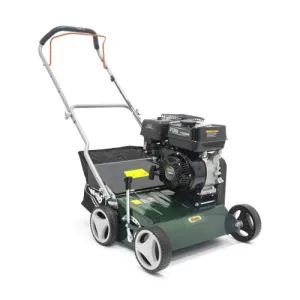You will need:
- Dethatcher/Scarifier
- Top soil
- Grass Seed
- Water/sprinkler
What Is Thatch?
Thatch is a layer of both living and dead grass shoots, roots and stems which lie between the grass blades and the soil on your lawn. A build-up of too much thatch is caused when turf produces organic debris quicker than it can be broken down. It is important to note that having some thatch on grass is not a bad thing as it is a good protector and can provide good insulation against temperature extremes and differences in soil moisture.
A small amount of thatch is needed on sports surfaces such as football and rugby pitches to protect and prevent injuries from falls. It also prevents turf damage from ball impact. Too much thatch however, can cause problems.
Why Should I Remove Thatch From My Lawn?
Thatch can cause extensive root damage by heating up and cooling down too quickly. Too much thatch restricts airflow to the turf which can encourage fungal diseases such as fusarium and red thread. Also, during rainy periods, thatch soaks up and holds a lot of water and in turn, acts like a sponge; this can be a problem as it may lead to root rot.
Method:
1) Before removing the thatch, the soil conditions need to suitable for scarification: ideally the soil needs to be moist but not soaking. Once the conditions are correct scarification can begin. We recommend using the Towable Dethatcher or the Petrol Scarifier.
2) After scarifying some areas of turf may look bare. To fix this, apply top soil and then grass seed.
For small/medium sized lawns, we recommend using a scarifier such as The Handy 2 in 1 Electric Scarifier. For larger areas, such as sports pitches or fields, we advise using a Towed Dethatcher.
For more information on controlling thatch, please get in touch with our technical sales team on 01522 246491.





